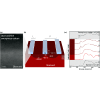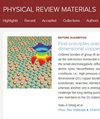Low-density diamondlike amorphous carbon at nanostructured metal-diamond interfaces
IF 3.4
3区 材料科学
Q2 MATERIALS SCIENCE, MULTIDISCIPLINARY
引用次数: 0
Abstract
Next-generation nanoelectronic, energy, and quantum technologies require increasingly stringent thermal, optical, mechanical, and electrical properties of component materials, often surpassing the limits of widely used materials such as silicon. Diamond, an ultrawide bandgap semiconductor, is a promising material for these applications because of its very high stiffness, thermal conductivity, and electron mobility. However, incorporating diamond into devices that require high-quality metal-diamond interfaces is challenging. In this work, we use a suite of electron microscopy measurements to reveal an ultrathin amorphous carbon layer that emerges at metal-diamond interfaces after electron beam lithography. Using extreme ultraviolet scatterometry, we nondestructively determine lower bounds on the layer's Young's modulus and thermal conductivity, which at and W/() are indicative of a diamondlike form of amorphous carbon with high bonding. However, extreme ultraviolet coherent diffractive imaging reflectometry and energy-dispersive x-ray spectroscopy measurements indicate a low and likely inhomogeneous density in the range of . The low density of such a stiff and conductive layer could indicate that it contains nanometer-scale voids or atomic-scale vacancies. The appearance of this unusual layer illustrates the nanofabrication challenges for diamond and highlights the need for better techniques to characterize surfaces and interfaces in nanoscale devices.

纳米结构金属-金刚石界面上的低密度金刚石状无定形碳
下一代纳米电子、能源和量子技术对元件材料的热学、光学、机械和电学特性的要求越来越严格,往往超过了硅等广泛使用的材料的极限。金刚石是一种超宽带隙半导体,具有极高的硬度、热导率和电子迁移率,是一种很有前途的应用材料。然而,将金刚石应用到需要高质量金属-金刚石界面的设备中具有挑战性。在这项工作中,我们利用一套电子显微镜测量方法揭示了电子束光刻后在金属-金刚石界面上出现的超薄无定形碳层。利用极紫外散射测量法,我们非破坏性地确定了该层的杨氏模量和热导率的下限,230GPa 和 1.1 W/(mK) 的杨氏模量和热导率表明该层是一种具有高 sp3 键的类似金刚石的无定形碳。然而,极紫外相干衍射成像反射测量法和能量色散 X 射线光谱法的测量结果表明,密度很低,而且很可能不均匀,在 1-2 克/立方厘米的范围内。如此坚硬的导电层密度如此之低,可能表明其中含有纳米级空隙或原子级空位。这种不寻常层的出现说明了金刚石的纳米制造所面临的挑战,并突出表明需要更好的技术来表征纳米级器件的表面和界面。
本文章由计算机程序翻译,如有差异,请以英文原文为准。
求助全文
约1分钟内获得全文
求助全文
来源期刊

Physical Review Materials
Physics and Astronomy-Physics and Astronomy (miscellaneous)
CiteScore
5.80
自引率
5.90%
发文量
611
期刊介绍:
Physical Review Materials is a new broad-scope international journal for the multidisciplinary community engaged in research on materials. It is intended to fill a gap in the family of existing Physical Review journals that publish materials research. This field has grown rapidly in recent years and is increasingly being carried out in a way that transcends conventional subject boundaries. The journal was created to provide a common publication and reference source to the expanding community of physicists, materials scientists, chemists, engineers, and researchers in related disciplines that carry out high-quality original research in materials. It will share the same commitment to the high quality expected of all APS publications.
 求助内容:
求助内容: 应助结果提醒方式:
应助结果提醒方式:


